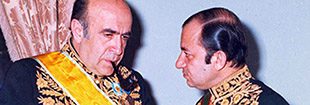Farshchian’s life also included a remarkable personal experience that reinforced his spiritual beliefs. He reportedly became an honorary attendant of the shrine of Imam Reza, the eighth Shiite Imam, after receiving healing for his crippled hand—an event he attributed to divine intervention. This experience deepened his engagement with Shiite themes, which became a recurring element in his most celebrated works.
Artistic Philosophy and Style
Farshchian’s art is distinguished by its combination of technical mastery, deep symbolism, and an unmistakable personal style. His paintings often feature:
-
Flowing, Curved Lines: Creating a sense of perpetual motion and energy.
-
Vibrant, Layered Colors: Often blending in waves, creating a dreamlike atmosphere.
-
Symbolic Imagery: Figures, animals, and landscapes imbued with allegorical meaning.
-
Integration of Poetry: Visual interpretations of Persian poets like Hafez, Rumi, and Ferdowsi.
Although rooted in the miniature tradition, his compositions broke free from the rigid geometries of classical works. He introduced rounded, expansive spaces and dynamic movement, allowing his figures to almost dance across the canvas. This fluidity gave his paintings an emotional immediacy that appealed to both Iranian and international audiences.

